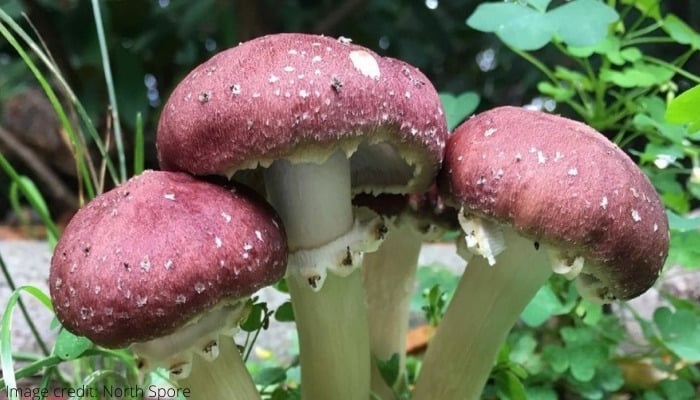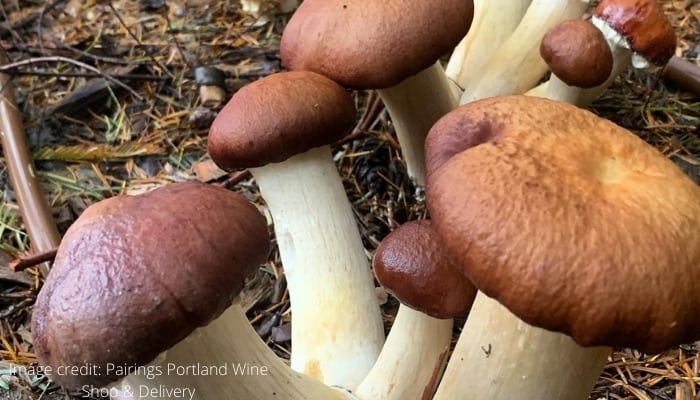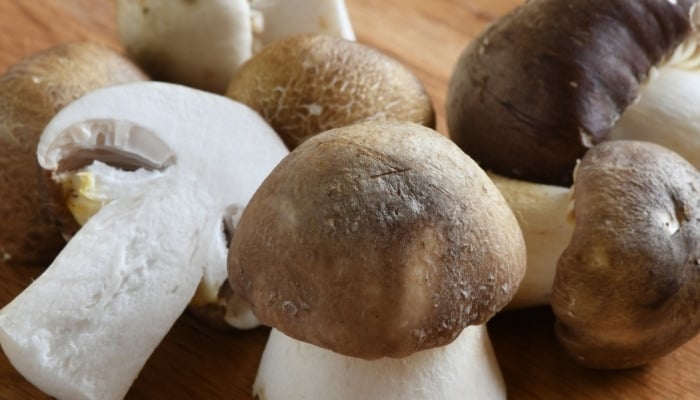The species of agaric mushroom known as Wine cap or Garden Giant (Stropharia rugosoannulata or King Stropharia) is characterized by its burgundy hue and belongs to the Strophariaceae family.
Are wine cap mushrooms easy to grow? Wine cap mushrooms are some of the easiest mushrooms to grow. They require zero previous experience and no tools to plant. Simply clear a surface on the ground, and layer it with wood chips, spawn, and straw. Repeat the process as many times as you wish, and top it all off with a layer of wood chips.
Read on below to learn all about growing these tasty mushrooms both indoors and outdoors.
Wine Cap Mushrooms
The wine cap mushroom, scientifically known as the Stropharia rugosoannulata, is also commonly called King Stropharia, Garden Giant, or simply burgundy mushroom.
The mushroom is an agaric type belonging to the family Strophariaceae.
They originate from North America and Europe but have since then been introduced to New Zealand, Colombia, Australia, and other places around the world.
In nature, the mushroom pops up in wooded areas during both summer and autumn. Not only is it easy to spot, but it’s tasty and abundant as well as easy to propagate.
An interesting aspect of the species that sets it apart from other mushrooms is that it attacks Panagrellus redivivus (nematodes) with its acanthocytes (spiny cells) and eventually digests them.
The optimal fruiting temperature for wine caps is between 50°F and 70°F, hence they are typically fruiting in nature during the summer and autumn.
Wine Cap Mushroom Identification & Appearance
The wine cap mushroom has a convex, burgundy cap that grows up to 12-inches wide. The mushroom grows up to nearly 8 inches tall.
Its gills are pale gray, eventually turning brownish purple. The edible flesh of the mushroom is white.

Wine Cap Mushroom Growth Stages
Mushrooms’ growth stages a similar but slightly different than the stages of growth plants go through:
- Composting. The first stage is preparing a bed of composting for your mushrooms.
- Spawning. During this stage, mycelial culture is injected into the sterile growing medium.
- Casing. A moisture-retaining top-dressing gets added to the mix in order for fruiting to occur.
- Pinning. This is the stage where tiny little mushrooms begin to appear.
- Cropping. The final stage consists of multiple 3- to 5-day harvests followed by a few days of no mushrooms.
Wine cap mushrooms in particular mature between 2 months and 1 full year after inoculation and casing. That said, once they start turning from pins to buttons, they can technically be picked.
However, you may also wait a few days for the buttons to open up into larger and meatier caps before cropping them.
Wine Cap Mushroom Taste
The wine cap is often used as a replacement for meat as the flesh is white and firm (similar to chicken). The taste, however, is nothing like chicken.
The wine cap’s flavor is nutty and mildly earthy. Some wine caps have a slightly potato-ish taste as well.
Wine Cap Mushroom Look-Alikes
These common mushrooms aren’t the most unique looking, as you can tell from pictures of the species as well as the description above. Unfortunately, there are several look-alikes:
- Amanita (particularly Death Caps)
- Agaricus sp.
- Agrocybe sp.
Wine Cap Mushroom Uses
In the kitchen, young wine cap mushrooms are great for adding to risottos, soup, and salads. They can also be prepared as a replacement for meat.
Older specimens are best dried for use later. Besides eating them, wine caps are also used frequently as garden fertilizer.
Wine Cap Mushroom Health Benefits
The wine cap has several health benefits: it’s a great source of fiber and protein, vitamin D, calcium, amino acids, copper, iron, and more.
In addition, like most mushrooms, the wine cap is low in calories and high in antioxidants. Furthermore, they may help with various ailments and diseases (such as cancer).
Wine Cap Mushroom Price
Purchasing wine caps through an online retailer like Amazon (at the time of posting this article) costs approximately $5 per pound ($11 per kilogram).
Buying your wine cap mushrooms locally is likely to come with a slightly higher price. That said, you can always buy spawn for $20 to $30 per pack and grow some of your own mushrooms.
Growing Guide for Wine Cap Mushrooms
Here are the steps for growing wine cap mushrooms outdoors from start to finish:
1. Prepare the Ground
The first step to growing wine cap mushrooms outside is exposing the surface soil. Use a shovel and rake to do so. Once your earth is roughed up, add the first layer of spawn.
Typically, spawn is spread approximately 3 feet by 3 feet (though you can do smaller- or larger-sized spreads, as you wish).
2. Start Layering in Wood Chips
After you’ve prepared the first layer of the stack, cover the spread with wood chips. Ideally, each layer should be between 1 to 2 inches thick. Make sure the layers are even.
You shouldn’t be able to see through to the spawn below by any means (even if you opt for less than 1-inch thick layers).
3. Add More Spawn, Start Laying in Sawdust
When you’ve stacked your first layer of wood chips into the pile, add another layer of spawn before topping it off with sawdust for the first time.
This layer helps retain moisture, allowing the spawn to draw from it in order to stay well hydrated. It also helps increase the humidity of the stack.
4. Continue Layering and Adding Spawn
After the first layer of sawdust, continue layering the stack and adding spawn. At this point, the order becomes woodchips, spawn, sawdust, and repeat.
You’re finished with adding layers when you run out of spawn (or decide it’s enough for your needs).
5. Add a Final Layer/Top-Dressing
Once you’ve added the final layer of spawn, you need to top it all off with a “casing” or top-dressing.
An extra thick layer of sawdust and wood chips suffices, though adding a bit of peat (or loamy earth/soil) to the mix is highly recommended.
How To Grow Wine Cap Mushrooms Indoors
Growing wine cap mushrooms indoors is slightly different than outdoors:
1. Prepare/Sterilize the Kit’s Components
Rather than peeling back grass and raking clear a patch of ground to plant your spawn outside, indoor kits are much simpler: simply open them up and prepare accordingly.
Some kits are set up for growing in totes; others are for bags or boxes. Now is also the time to sterilize things if you are doing a DIY kit, especially the substrate.
2. Set Up the Substrate in the Bag or Box
Inside your kit, there are a few things that you prepared during step one. One is mycelium, most likely packed in sawdust or syringes. The other is compost, possibly a block or in a bag.
Follow the instructions on your kit, and get the bag/box set up with your substrate.
3. Add the Spawn to the Sterile Substrate
Adding the spawn is usually referred to as inoculating.
This is when you inject the syringes of liquid mushroom culture or sprinkle and moisten spawn mixed with sawdust into your carefully prepared and sterilized substrate growing medium.
4. Mix and Add the Casing
The casing is the final step to setting up your indoor wine cap mushroom kit.
Depending on the contents of your kit, this step usually consists of mixing sawdust, peat, and/or other ingredients with water before applying it to the top of the bag, box, or block.
Wine Cap Mushroom Spawn
Mushroom spawn is simply a substrate with the mushroom mycelium of a specific species already present and growing in it.
You can order mushroom spawn online, buy it locally, or even make it yourself.
Wine Cap Mushroom Spawn Sources
Buying mushroom spawn is always best done through a well-known and credible source (especially when shopping online).
That’s why we’ve provided brief reviews of several of the most highly recommended wine cap mushroom spawn sources below:
Field & Forest Products
This popular wine cap spawn source comes in a 5.5-pound bag and is made for use with wood chips and sawdust.
The manufacturer offers instructions on how to use it as well as information on growing mushrooms in general, making it a good choice for newbies and pros alike.
The product is available as sawdust spawn, pegs, and garden kits.
North Spore
This 5-pound bag of wine cap spawn comes from one of the most well-known and trusted names in the business, North Spore.
The contents of the bag are good for 6 months on the shelf and are enough to grow two or three years of mushrooms. The spawn is beginner friendly, making it ideal for first-time growers.
Cascadia Mushrooms
These USDA-approved/certified organic mushroom spores are guaranteed to grow well in wood chips, straw, or sawdust.
The spawn is good for growing three years worth of mushrooms if properly propagated. One bag inoculates a spread of up to 4 feet by 4 feet and is easy to work with for growers of all skill levels.
Wine Cap Mushroom Liquid Culture
Mushroom liquid culture is simply mushroom mycelium that is living inside a bit of liquid (water with some nutrients in it).
The following review is our pick for the best wine cap mushroom liquid culture to purchase online:
Root Mushroom Farm
The Root Mushroom Farm wine cap mushroom liquid culture comes in 30 individual 10cc syringes of clean and active wine cap mycelium living in liquid culture.
Each batch is tested by the producers before being inventoried or shipped to customers. That’s why the product is backed by a 100% satisfaction guarantee!
How Long Do Wine Cap Mushrooms Take To Grow?
Typically, wine cap mushrooms take around 60 days to 300 days or more to grow.
The level of cleanliness and sterilization involved with your mushroom “planting” process and how well you manage your growing operation in general have a major impact on how long it takes for them to grow from spawn to fruition.
When Should I Start a Wine Cap Mushroom Bed?
Early spring or early fall are generally the most ideal times to begin a wine cap bed. The cooler temperatures make it easier to prevent rapid moisture loss that can be problematic in the summer.
However, beds can be started in the summer as long as you are diligent in not allowing the beds to dry out.
The most straightforward and cost-effective way to start a wine cap mushroom bed is also the easiest. Start by creating a clear spot in the soil, and then add a bit of wood chips.
After the area is prepped, add your first layer of spawn, followed by sawdust, straw, or more wood chips. Repeat the process until you’re out of spawn.
When To Harvest Wine Cap Mushrooms
Wine cap mushrooms are best harvested several days after pinning when they’re just itty bitty things that still haven’t dropped their spores.
The reason being is they taste better and offer more nutritious value while they’re still so young.
Once they open their caps fully and grow larger, they don’t taste as fresh, and they get tougher and stringier too.

How Many Times Can You Harvest Wine Caps?
Wine caps may be harvested several times in a row, depending on how healthy your colonies are. Generally speaking, three to four days after you harvest wine caps you can re-harvest.
You can wait 5 or 6 days if you want the largest mushrooms possible, but they’ll have already opened up and dropped their spores.
How To Store Wine Cap Mushrooms
The best way to store wine cap mushrooms is by dehydrating them, either in a dehydrator or on a classic drying screen.
Once prepared, simply toss them into some containers and store them in the freezer. Plastic containers with lids or mason jars work just fine.
Even freezer bags will do the trick if you plan on using them soon.
Common Problems When Growing Wine Cap Mushrooms
Now that we’ve thoroughly discussed how to grow wine cap mushrooms both indoors and outdoors, let’s have a look at solutions for common problems with growing them:
1. Contaminating Spawn
When growing mushrooms on your own, especially outside, you must be absolutely sure that you’re only adding positively identified spawn.
The problem is, even if you know for certain that your spawn is pure wine caps, native spores can blow in and contaminate your mushroom growing operation.
Solution
Set your outdoor mushroom spawn up somewhere with coverage from the wind. Otherwise, consider building a wind block to protect it from rogue spores traveling in the air.
2. Adding Too Much Moisture
Adding too much moisture to layers of woodchips, straw, and mushroom spawn can really hamper things.
Excess water makes your operation vulnerable to harmful mold, bacteria, and soil-borne diseases as well as pests that are drawn to moisture.
Solution
Avoid using a bucket/open-face container to apply water. Instead, use a garden hose with a sprayer or a watering can with a filter/sprinkler head.
3. Letting the Spawn Dry Out
On the flipside of overwatering your spawn, letting it dry out is just as bad. With no moisture, all growth comes to a screeching halt.
Even worse, if it’s dried out completely, it probably won’t grow new batches of mushrooms.
Solution
Keep a reminder on your phone so you remember to check your mushroom spawn every few days. Lightly water if at any time it’s even remotely drying out.
4. Improper Layering
Failing to properly layer your mushroom spawn, also known as “casing” it, may lead to much smaller harvests of wine caps when the time comes.
Solution
Make sure to layer your mushrooms with wood chips or substrate, spawn, straw or sawdust, more wood chips, more spawn, and more straw or sawdust.
Repeat the process like you are making lasagna (as many times as possible).
Final Thoughts
Wine caps are an excellent mushroom for growing by yourself at home.
They’re good for eating, have plenty of nutritional value, and the spawn is also easy to get your hands on and propagate into an abundance of fresh mushrooms.
Follow the instructions in this article, including the common problems and solutions section, as often as necessary while learning how to grow your own wine caps!
Image credits: North Spore, Pairings Portland Wine Shop & Delivery

